Eyo festival
The Eyo Festival, otherwise known as the Adamu Orisha Play, is a Yoruba festival unique to Lagos, Nigeria.[1] In modern times, it is presented by the people of Lagos as a tourist event and[2] due to its history, is traditionally performed on Lagos Island.
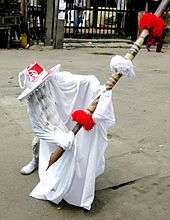
The Eyo
The word "Eyo" also refers to the costumed dancers, known as the masquerades that come out during the festival. The origins of this observance are found in the inner workings of the secret societies of Lagos.[3] Back in the days, The Eyo festival is held to escort the soul of a departed Lagos King or Chief and to usher in a new king. It is widely believed that the play is one of the manifestations of the customary African revelry that serves as the forerunner of the modern carnival in Brazil.[4] On Eyo Day, the main highway in the heart of the city (from the end of Carter Bridge to Tinubu Square) is closed to traffic, allowing for procession from Idumota to the Iga Idunganran palace. The white-clad Eyo masquerades represent the spirits of the dead, and are referred to in Yoruba as "agogoro Eyo" (literally: "tall Eyo").[5]
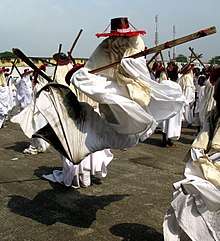
The first procession in Lagos was on the 20th of February, 1854, to commemorate the life of the Oba Akintoye.[6]
Here, the participants all pay homage to the reigning Oba of Lagos. The festival takes place whenever occasion and tradition demand, though it is usually held as part of the final burial rites of a highly regarded chief in the king's court.[1]
Among the Yorubas, the indigenous religions have largely lost the greater majority of their traditional followers to Christianity and Islam. Be that as it may, the old festivals are still almost universally observed as tourist attractions which generate a lot of revenue for government and small businesses around the Lagos Island venue of the Eyo festival. It is during these occasions that their traditional monarchs and nobles exercise the most of their residual power.
Order of events
In his book Nigerian Festivals, travel writer and culture reporter Pelu Awofeso notes: A full week before the festival[4] (always a Sunday), the ‘senior’ eyo group, the Adimu (identified by a black, broad-rimmed hat), goes public with a staff. When this happens, it means the event will take place on the following Saturday. Each of the four other ‘important’ groups — Laba (Red), Oniko (yellow), Ologede (Green) and Agere (Purple) — take their turns in that order from Monday to Thursday.
History
Historically, Iperu is the source, cradle and originator of Eyo in Nigeria and the world. There are 5 different branches/types of Iga Eyo in Iperu Akesan
Names of the families and Iga of Eyo each represents are:
- Iga Pakerike which is symbolized by red cap of éyo
- Iga Agbonmagbe, also symbolized by blue cap of éyo.
- Iga éyo Odoru
- Iga éyo Mogusen/Amororo
- Iga éyo Fibigbuwa
The major source of éyo in Iperu is the Iga éyo Pakeriké and other 4 are the Iperu Royal houses.
History made us to understand that Eyó was brought to Lagos to entertain an in-law which has now become something more celebrated in Lagos today.
Akesan aagbé wa! Remo asuwon ooo!
Festival dates
2000
Prohibited items
Here is a list of prohibited items at the festival:
- Okada motorcycle taxis
- Bicycles
- Sandals
- Suku - hairstyle that is popular among the Yorubas, one that has the hair converge at the middle, then shoot upward, before tipping downward.
- Smoking
- Female with head tie or head gear or any covering of the head
- male with cap of any kind
The masquerades are known to beat people who use any of the prohibited items at sight with their staffs.
Gallery
 Bridge pillars in Lagos showing Eyo figures
Bridge pillars in Lagos showing Eyo figures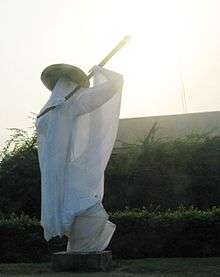 Eyo figure advertising upcoming festival
Eyo figure advertising upcoming festival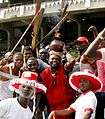 Members of the Eyo Iga Etti procession at the Eyo festival at Tafawa Balewa Square in Lagos, including a man carrying a burning pot on his head.
Members of the Eyo Iga Etti procession at the Eyo festival at Tafawa Balewa Square in Lagos, including a man carrying a burning pot on his head. The banner of the Eyo Iga Taiwo Olowo entering the TBS.
The banner of the Eyo Iga Taiwo Olowo entering the TBS. The banner of the Eyo Iga Opeluwa entering the TBS.
The banner of the Eyo Iga Opeluwa entering the TBS. The banner of the Eyo Awise entering the TBS.
The banner of the Eyo Awise entering the TBS. Masquerades in the Eyo Iga Etti procession.
Masquerades in the Eyo Iga Etti procession.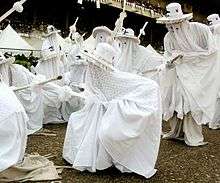 Eyo Olokun masquerades at the TBS. Eyo Olokun are connected with Olokun, the Yoruba deity of the sea.
Eyo Olokun masquerades at the TBS. Eyo Olokun are connected with Olokun, the Yoruba deity of the sea. Children in costume at the festival.
Children in costume at the festival.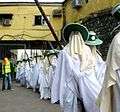 Masquerades of the Eyo Iga Sasi entering the TBS in Lagos in procession.
Masquerades of the Eyo Iga Sasi entering the TBS in Lagos in procession. A man carrying a burning pot on his head as part of a procession in a residential area of Lagos. Probably a member of Eyo Iga Etti.
A man carrying a burning pot on his head as part of a procession in a residential area of Lagos. Probably a member of Eyo Iga Etti.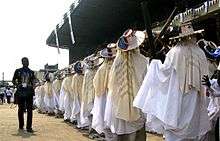 Masquerades of the Eyo Iga Faji parading in the TBS.
Masquerades of the Eyo Iga Faji parading in the TBS. A performer on stilts as part of the Eyo Agere Molokun procession parading in the TBS.
A performer on stilts as part of the Eyo Agere Molokun procession parading in the TBS. A packed lunch brought by the royal family for the 2011 Eyo festival, commemorating Prince Yesufu Abiodun Oniru.
A packed lunch brought by the royal family for the 2011 Eyo festival, commemorating Prince Yesufu Abiodun Oniru.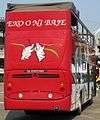 A bus with Eyo masquerades painted on the back, with the slogan "Eko o ni baje" (literally Lagos will not spoil, a colloquialism for Lagos will prevail).
A bus with Eyo masquerades painted on the back, with the slogan "Eko o ni baje" (literally Lagos will not spoil, a colloquialism for Lagos will prevail).
References
- "Nigerian Festivals". OnlineNigeria.com. Retrieved 24 November 2011.
- "The Lagos Carnival". Lagos Carnival Website. Lagos State Government. Retrieved 24 November 2011.
- F. W. Butt-Thompson; author, sketches by the (2005). West African secret societies : their organisations, officials and teaching. Whitefish: Kessinger Publ. ISBN 978-0-7661-5736-1 – via Google Books.
- http://www.travelintelligence.com/travel-writing/2919/Africa-and-Middle-East/Nigeria/Lagos/Lagos/The-Eyo-Festival.html
- "EYO: Its purpose and role in the history of Lagos". Eyo Festival Lagos website. Archived from the original on 27 November 2011. Retrieved 24 November 2011.
- Williams, Lizzie (2008). Nigeria (New ed.). Chalfont St. Peter: Bradt Travel Guides. pp. 148. ISBN 978-1-84162-239-2.
oba akintoye 1854.
- "https://m.facebook.com/story.php?story_fbid=2543906955641441&id=595432500488906&__tn__=%2AW#footer_action_list". 2000. External link in
|title=(help) - "Eyo Festival 2011: Orisha Adamu Eyo Masquerades on Lagos Island". Nigeria Entertainment News. November 23, 2011. Retrieved 23 November 2011.
- "Fela musical Concert, Eyo Festival, others to feature in Lagos @ 50 Celebrations". The News. 27 March 2017. Retrieved 16 May 2017.